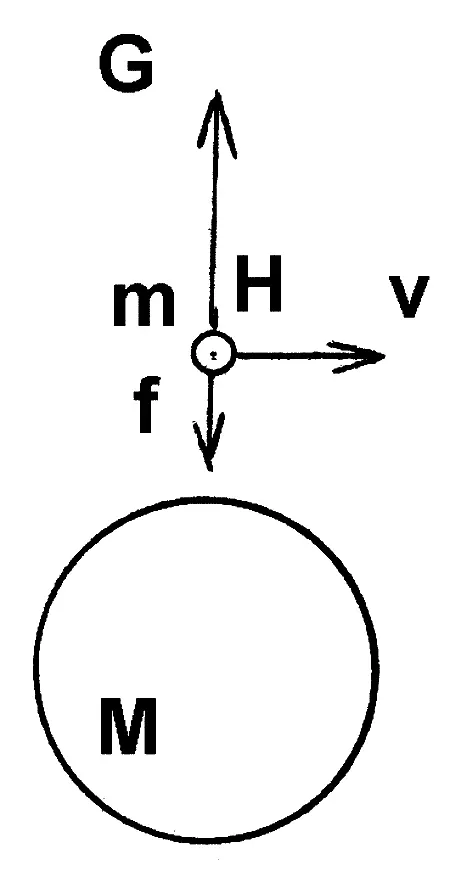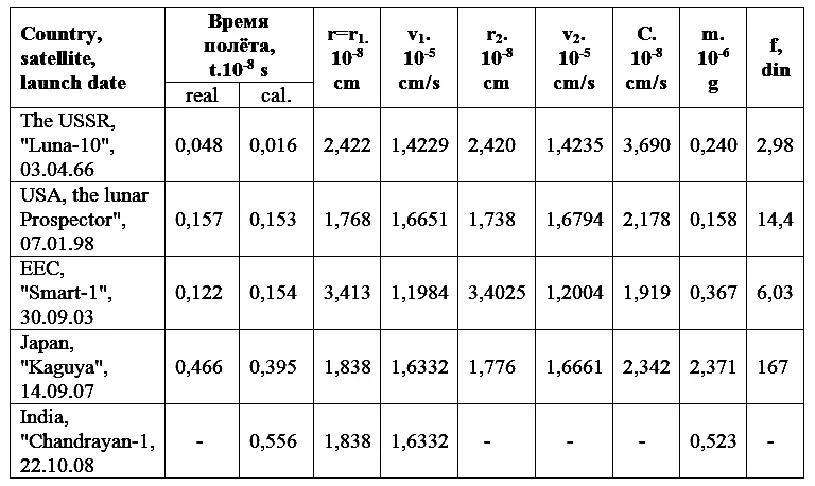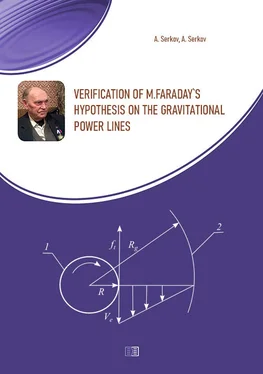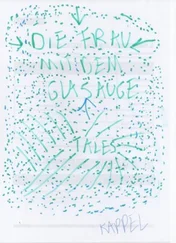To confirm advanced assumptions gravimagnetic braking bodies consider for example, at motion of satellites of the moon.
3. Gravimagnetic braking satellites of the moon
Starting with the first orbital flight of a satellite of the moon "Luna-10" [4, 5], which was launched on 3 April 1966, it became clear that the lunar satellites have abnormally high acceleration and the duration of their existence on the orbit is limited. Of all possible causes inhibition: perturbations due to the influence of the Sun and the Earth, the uneven distribution of mass, the presence of the moon, though very thin atmosphere, the impact of the solar wind – focused [6] non spherical shape of the moon. It was shown that perturbations caused by the non centric gravitational field of the Moon is 5-6 times larger than the perturbations due to the Earth's gravitation, and the latter exceeded the solar 180 times.
The main reason for the occurrence of braking forces of the moon satellites may not be the uneven mass distribution, in particular the no spherical character of the Moon. Any algorithm for calculating the impact of uneven distribution of mass, the result depends on the mass of the satellite. The larger the mass, there is stronger interaction and the less the lifetime of satellites in orbit.
However, the available data do not support this conclusion. For example, the satellite Kaguya" had a lot 2371 kg, and the duration of his stay in orbit amounted to 539 days, while the lunar Prospector", having mass 158 kg, ceased to exist after 182 days. As will be shown below, the deceleration time of the Moon satellites does not depend on their mass.
The scheme gravimagnetic braking of the moon satellites is shown in Fig. 2. A satellite with mass m moves with velocity v, traversing radially spaced the force lines of the gravitational field G. The direction of the intensity vector occurring due to the motion of the satellite is perpendicular to the plane of the figure upwards. A satellite is braking by force f that causes the decrease of the orbital distances. By analogy with electrodynamics braking is accompanied by the gravitational radiation at a rate equal to the constant C in equation (1).

Fig. 2. Scheme gravimagnetic braking the lunar satellite: a satellite with mass m moves with velocity v, traversing radially spaced force lines G of the Moon gravitational field (M); the direction of the intensity vector gravimagnetic field arising due to the motion of the satellite perpendicular to the plane of the drawing up; a satellite is retarding force f that causes the decrease of the orbital distance.
Braking force satellite f in addition to equation 1 can be expressed by the equation of momentum:
ft = m(v 2– v 1), (2)
where m is the satellite mass, t is the time of braking, v 1and v 2are the velocities before and after braking. Combining equations (1) and (2) obtain a convenient expression for calculating the time of flight of the satellite:
t = (C/GM) 2r 3(v 2– v 1), (3)
where t is the time of flight, C is a constant having the dimension of velocity cm/s, G is the gravitational constant 6,67.10 -8cm3/G2, M is the mass of the Moon 0,735.1026 g, r – average orbital distance (the semi major axis) at the beginning of the flight, v 1and v 2are the initial and final orbital velocity, calculated at an average orbital distance.
Returning to the question of the effect of aspheric of the moon on the braking of its satellites, note that in equation (3) expressing the time of flight the satellites is no their mass. This confirms the previously made conclusion about the independence of the flight time from the mass of the satellite.
The constant C in equations (1) and (2) if you follow the accepted analogy with electrodynamics, by definition, is the speed of gravitational radiation. Thus, equation (3) can be used to calculate dynamic gravitational constant, i.e. the velocity of propagation of gravitational waves.
The constancy of the constants when calculating for different satellites will confirm the correctness of the methodological approach. Below is data for the calculation of the constants for the evolution of the orbits of the fife satellites of the Moon, including the Soviet satellite Luna-10", American satellite "the lunar Prospector", a satellite of the European space Agency's Smart-1", as well as Japanese and Indian satellites "Kaguya" and "chandrayan-1.
Consider the launch and flight of Sputnik "Luna-10". First, "Luna-10" was put into orbit an artificial satellite of the Earth. Then, using the upper stage, the speed of the station was reduced to 10.9 km/s. At that speed, the duration of the flight to the Moon was slightly less than three and a half days.
Then was the correction of the trajectory, after which the station entered the sphere of gravitational influence of the Moon.
At the final stage of the flight (800 km from the Moon) station has been previously appropriately focused and calculated point remote from the surface of the moon for 1000 km was included braking engine unit and the speed was reduced from 2.1 to 1.25 km/s, which provided the transfer station under the action of the attraction of the Moon with the span of the trajectory on selenocentric orbit with the following parameters: the greatest distance from the surface of the Moon – 1017 km (apocenter 2,755.108 cm); smallest – 350 km (pericenter putting on 2,088.108 cm); the average distance (the semimajor axis) – 2,422.108 cm; average orbital speed – 1,4229.105 cm/s; period of revolution around the moon – 2 hours 58 minutes 15 seconds; the angle of inclination of the satellite's orbit to the plane of the lunar equator – 71° 54. The mass of the spacecraft after separation from the booster was 1582 kg, the mass of the lunar satellite 240 kg
Artificial satellite of the Moon "Luna-10" there were active 56 days (0,0484.108 (s) having 460 revolutions around the Moon. After the batteries have been depleted, the relationship was terminated on May 30, 1966. Orbit at this time had parameters: minimum destruction of 378 km (pericenter 2,116.108 cm), the greatest destruction of 985 km (apocenter 2,723.108 cm and an inclination of 72.2 degrees. The average distance (the semi major axis) – 2,420.108 cm. Average orbital speed – 1,4235.105 cm/s.
Substituting the given data into the formula (3), find the value of the constant C = 3,694.10 8cm/s Calculated data are presented in Table 1. Perform similar calculations for other travelers of the Moon.
Table 1. The calculation of the duration of the flight, the constants C and braking force to the satellites of the Moon.

Accordingly, the orbital velocity at the beginning of the highlighted portion of the orbit v 1= 1,665.10 5cm/s and at the moment of falling v 2= 1,680.10 5cm/s Substituting the above values in the formula 3, we get the value of the constants C = 2,25.108 cm/s, that is close in order of magnitude to the value of the constants calculated for the satellite "Luna-10. The satellite of the moon, Smart-1 (Smart-1: the acronym for Small Mission for Advanced Research in Technology) launched by the European space Agency September 30, 2003 [8]. Initially, it was launched into an elliptical low earth orbit typical of telecommunication satellites with the help of the rocket Ariane-5. Then the output on the lunar orbit was carried out using a low-power (thrust force of 0.07 N) ion propulsion and lasted 16 months.
After moving into the area of the gravity of the Moon and the braking propulsion system on November 11, 2004 "Smart-1" has been translated into lunar orbit. The mass of the satellite 367 kg After number of maneuvers in the period from 28 February to July 18, 2005 the satellite was in free flight, that is, without the inclusion of the propulsion system. The orbital parameters at the beginning of this period: apocenter 4,6182.10 8cm and the pericenter 2,2087.10 8cm. The average distance (the semi major axis) 3,4134.10 8cm After a flight during 0,121.10 8s apocenter decreased to 4,4957.108 cm, and the pericenter increased to 2,3493.10 8cm. The average distance decreased to 3,4025.10 8cm.
Читать дальше












